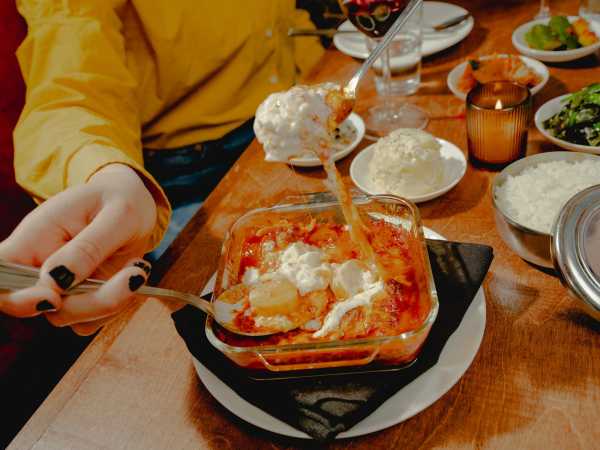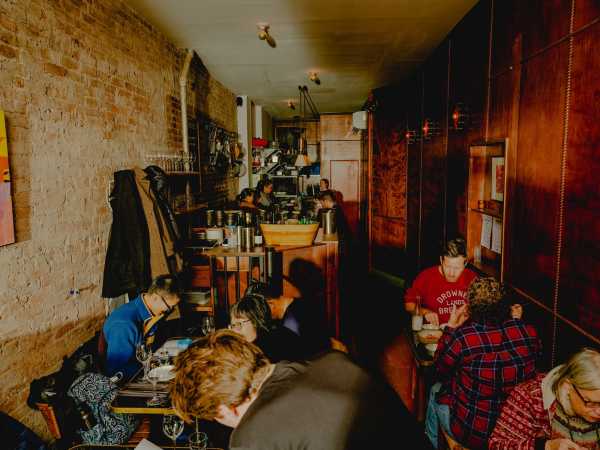
Save this storySave this storySave this storySave this storyYou’re reading the Food Scene newsletter, Helen Rosner’s guide to what, where, and how to eat. Sign up to receive it in your in-box.
Sunn’s, which opened late last year, on the Lower East Side, is the real-deal-restaurant landing spot for the chef Sunny Lee, of the long-running, much adored pop-up Banchan by Sunny. Behind a yellow-and-green painted exterior in the heart of Dimes Square, it’s a slip of a space, twenty-four seats at tables and counters puzzled together in a closet-size room that more properly ought to hold ten bodies fewer—but there’s an ineffable friendliness to Sunn’s, as if it were pumping relaxed geniality in through the vents, and the squeeze feels like an extension of the restaurant’s warmth. I was nearly pushed in bodily by a squall of snow one particularly icy evening, and after I de-coated myself and dropped into a seat at the wood-clad dining bar at the back of the room, a server pressed a drink into my hands: a Sunn’s-style hot toddy, made with soju, yuzu, and lemon, in a classic We Are Happy to Serve You paper cup.

Squishy-firm tteokbokki (rice cakes) are tossed in a gochujang-tomato sauce and baked, in personal-sized casserole dishes, under a snowy layer of stracciatella cheese—an inspired adaptation of Italian cuisine.
Sitting at the counter, I could see that Lee was in the kitchen (what a kitchen! It’s a tight linear stretch running behind the counter like a studio-apartment galley setup), as she is seemingly every evening. With a sous or two at her side, she m.c.’s the show, plating and garnishing and chatting gaily with customers and staff. Here, as at her pop-ups, Lee wears chefdom with a joyful lightness. She makes it look easy—conceiving the dozens of tiny dishes, doing all the background prep and labor that goes into this kind of pickle-and-fermentation-heavy cuisine, and nailing the physical choreography, but, more potently, she makes it feel fun. There’s artistry to her dishes, but not a shred of an artist’s self-seriousness. Upon a decidedly Korean foundation, she nimbly experiments with global harmonics: a special of roasted and pickled mushrooms, meaty oyster and chewy wood-ear together, tossed in a garlicky tahini dressing, or an eggplant namul (long-stewed, until the vegetable collapses like an overstressed pop star) with an unexpected caponata-ish, Eastern European-ish flourish of raisins and bits of marinated celery.

Sunn’s is a slip of a space, but the squeeze feels like an extension of the restaurant’s warmth.
Lee hosted her pop-up for nearly a decade before locking down a proper restaurant. She’s a veteran of kitchens including Blue Hill and Estela, and Banchan by Sunny was a way for her to explore the small side dishes, often numbering in the dozens, that accompany traditional Korean meals—a dizzying, heterogeneous array of pickled things, fermented things, meats and vegetables, cooked and raw, spicy and soothing. Banchan remain a focus at Sunn’s, with a glorious sampler of half a dozen or so ever-changing tiny dishes. These can include a slippery slice of acorn jelly, marinated in vinegar and soy; a scoop of lusciously creamy potato salad; and a pile of shocking-orange Napa-cabbage kimchi smoldering with chiles.

Lee, a veteran of kitchens including Blue Hill and Estela, was inspired to explore the small side dishes, often numbering in the dozens, that accompany traditional Korean meals.
With a lidded metal bowl of hot white rice alongside, Lee’s banchan could make a perfectly satisfying meal on their own, but it would be a shame to miss a chance to experience the rest of the restaurant’s short, clever menu. Sunn’s Salad, a colorful arrangement of seasonal vegetables (purple radicchio and tart pickled radish on one visit, slices of lotus root on another) is meant to be eaten with your hands—“vegetable nachos,” a server put it—and reveals layers of delight in each bite: bits of sweet dates, swoops of velvety sesame jang. A hwe (raw seafood) preparation featured sweet scallops and pale pink hunks of amberjack dressed in sesame oil and salt, with ruffles of cloud-ear mushrooms providing a bit of pleasing, jellyfish-adjacent chew, served next to a pile of julienned burdock dressed in a yuzu chogochujang. “My father caught these scallops himself!” Lee announced, with radiant pride, when she presented the dish. Squishy-firm tteokbokki (rice cakes) tossed in a gochujang-tomato sauce and baked, in personal-sized casserole dishes, under a snowy layer of stracciatella cheese is both proof of the universal appeal of Italian cuisine and an inspired adaptation. Followed by a bowl of textbook-perfect aged kimchi, pork belly, and tofu jjim (a stew of boiled meat or seafood), a meal here is a lesson in how many ways food can be wondrously homey, to a wild and joyous point, almost emotionally reparative.

The restaurant is behind a yellow-and-green exterior in the heart of Dimes Square.
Lee opened Sunn’s in partnership with the wine maven Grant Reynolds, of Parcelle, who oversees the quite excellent wine program; as befits such a petite restaurant, the list is small but mighty, and by-the-glass options are limited to one red, one white, one orange (it’s Dimes Square, after all), and a “special pour” of whatever the staff is into at the moment. The wines pair uncannily well with Lee’s high-saturation flavors—even a spicy-tuna hand roll, which maybe leaned a little too heavily on the spicy, still did great against a bright, acidic Loire Valley red.
It’s been a good few months for pop-ups putting down brick-and-mortar roots on the Lower East Side, and adding some serious wine cred to the mix. Ha’s Snack Bar, which has been open since January, is from the husband-and-wife team behind Ha’s Đặc Biệt, a prolific Vietnamese pop-up that was almost as famous for the speed at which tickets to its events sold out as it was for its thrilling, sophisticated, often unexpected food. Pete Wells, the former Times restaurant critic, declared its 2021 residency (a pop-up double bill with Kreung Cambodia) at Outerspace, in Bushwick, “the restaurant of the summer”—coincidentally, the day after being so dubbed, Ha’s owner-chefs Sadie Mae Burns and Anthony Ha quit the residency, the culmination of a long period of difficulty in their relationship with their host.
Helen, Help Me!
E-mail your questions about dining, eating, and anything food-related, and Helen may respond in a future newsletter.
Ha’s was back almost immediately, partnering with restaurants again—and what a set of restaurants! The Four Horsemen! Yellow Rose! Bistro Paul Bert, in Paris! Still, I imagine that, for Burns and Ha, to now be able to work within the stabilizing framework of a lease, and plumbing, and their own choice of color on the walls—mostly white, it turns out, in a romantic, dimly lit sort of way, though the open kitchen in the back of the cozy space anchors the whole room on big square tiles of primary, elementary-school blue—it must be a relief. (But maybe not an unalloyed one: a Ha’s reservation has been one of the hottest tickets in town lately, the buzz so strong it’s verging on a roar; when Burns and Ha learned I’d be writing about the restaurant, they politely requested that I not, saying that they “are not looking for any additional press coverage at this time.”) The chalkboard menu lists a daily-written lineup of dishes, their flavors legibly Vietnamese but with an appealing dose of cool-kid weirdness, and a decidedly more-French-than-you-might-expect French inflection. A grated-carrot salad, for example, that stodgiest of Parisian luncheon dishes, is here jolted into sizzling vividity with cara-cara orange segments and rau ram (Vietnamese coriander), an herb whose flavor is so forcefully green that it almost verges on heat. Escargot, little swirls of chewy slime, swam in an ocean of sizzling, tamarind-spiked butter fiery with fresh garlic. A scallop crudo was dressed in limequat juice and capers and so many tingly peppercorns that it set my lips aflame. Hunks of braised leek stood upright on a bed of the softest, eggiest sauce gribiche, doused in sweet-hot chile sauce. The vibe, if it must be distilled, is flawless; it’s impossible to be unhappy eating cilantro-garnished pâté on a wedge of baguette while Joan Armatrading breaks everyone’s heart over the sound system. On each of my visits, after welcoming me in, a server delivered a line with the inflection of a caution to cautious diners, a warning and a promise: “Everything contains fish sauce.” Go ahead, threaten me with a good time. ♦
Sourse: newyorker.com







